An Integrated Decision-Making Framework for Mitigating the Impact of Urban Heat Islands on Energy Consumption and Thermal Comfort of Residential Buildings
Abstract
1. Introduction
2. Materials and Methods
2.1. Case Study
2.2. Characteristics of the Study Zone
2.3. Micro-Climatic Simulations
2.4. Proposed Strategies
- Case A—Current situation
- Case B—Changing the low-albedo materials with high-albedo ones
- Case C—Nature-based solutions (NBSs)
- Case D—Changing building façade materials, including green roofs
2.5. Building Energy Performance Simulations
2.6. KEMIRA-M Calculations
3. Results and Discussion
3.1. Micro-Climatic Simulation Results
3.2. Comparison of the Proposed Strategies
3.3. Building Energy Performance Results
3.4. KEMIRA-M Calculation Results
- x1:“Total energy consumption” is needed to be the lowest one.
- x2: “Thermal comfort” is needed to be the highest one.
- y1: “Capital cost” is needed to be the lowest one.
- y2: “Installation flexibility” is needed to be the lowest one.
- y3: “Lifetime” is needed to be the highest one.
4. Conclusions
Author Contributions
Funding
Institutional Review Board Statement
Informed Consent Statement
Data Availability Statement
Acknowledgments
Conflicts of Interest
References
- IEA. Energy Technology Perspectives 2020—Special Report on Clean Energy Innovation. Available online: https://www.iea.org/reports/energy-technology-perspectives-2020 (accessed on 25 April 2023).
- Turhan, C.; Atalay, A.S.; Akkurt, G.G. Green Smart Cities: Living Healthily with Every Breath. In Proceedings of the 7th International Istanbul Smart Grids and Cities Congress and Fair (ICSG), İstanbul, Türkiye, 25 April 2019. [Google Scholar]
- United States Environmental Protection Agency. Available online: https://www.epa.gov/heatislands#:~:text=Heat%20islands%20are%20urbanized%20areas,as%20forests%20and%20water%20bodies (accessed on 25 April 2023).
- Battista, G.; Evangelisti, L.; Guattari, C.; Roncone, M.; Balaras, C.A. Space-time estimation of the urban heat island in Rome (Italy): Overall assessment and effects on the energy performance of buildings. Build Environ. 2023, 228, 109878. [Google Scholar] [CrossRef]
- UNEP. Global Status Report for Buildings and Construction: Towards a Zero-Emission, Efficient and Resilient Buildings and Construction Sector. Available online: https://wedocs.unep.org/bitstream/handle/20.500.11822/34572/GSR_ES.pdf?sequence=3&isAllowed=y (accessed on 20 April 2023).
- Romano, P.; Prataviera, E.; Carnieletto, L.; Vivian, J.; Zinzi, M.; Zarrella, A. Assessment of the Urban Heat Island Impact on Building Energy Performance at District Level with the EUReCA Platform. Climate 2021, 9, 48. [Google Scholar] [CrossRef]
- Li, X.; Zhou, Y.; Yu, S.; Jia, G.; Li, H.; Li, W. Urban heat island impacts on building energy consumption: A review of approaches and findings. Energy 2019, 174, 407–419. [Google Scholar] [CrossRef]
- De Santolini, L.; Fraticelli, F.; Fornari, F.; Calice, C. Energy performance assessment and a retrofit strategies in public school buildings in Rome. Energy Build. 2014, 68 Pt A, 196–202. [Google Scholar] [CrossRef]
- Jige, S.; Li, C. Urban form and building energy use: A systematic review of measures, mechanisms, and methodologies. Renew. Sustain. Energy Rev. 2021, 139, 110662. [Google Scholar] [CrossRef]
- Aleksandrowicz, O.; Vuckovic, M.; Kiesel, K.; Mahdavi, A. Current trends in urban heat island mitigation research: Observations based on a comprehensive research repository. Urban Clim. 2017, 21, 1–26. [Google Scholar] [CrossRef]
- Battista, G.; Pastore, E.M. Using cool pavements to mitigate urban temperatures in a case study of Rome (Italy). Energy Procedia 2017, 113, 98–107. [Google Scholar] [CrossRef]
- Sedaghat, A.; Sharif, M. Mitigation of the impacts of heat islands on energy consumption in buildings: A case study of the city of Tehran, Iran. Sustain. Cities Soc. 2022, 76, 103435. [Google Scholar] [CrossRef]
- Seletković, A.; Kičić, M.; Ančić, M.; Kolić, J.; Pernar, R. The Urban Heat Island Analysis for the City of Zagreb in the Period 2013–2022 Utilizing Landsat 8 Satellite Imagery. Sustainability 2023, 15, 3963. [Google Scholar] [CrossRef]
- Makvandi, M.; Li, W.; Ou, X.; Chai, H.; Khodabakhshi, Z.; Fu, J.; Yuan, P.F.; Horimbere, E.D.L.J. Urban Heat Mitigation towards Climate Change Adaptation: An Eco-Sustainable Design Strategy to Improve Environmental Performance under Rapid Urbanization. Atmosphere 2023, 14, 638. [Google Scholar] [CrossRef]
- Ullah, N.; Siddique, M.A.; Ding, M.; Grigoryan, S.; Khan, I.A.; Kang, Z.; Tsou, S.; Zhang, T.; Hu, Y.; Zhang, Y. The Impact of Urbanization on Urban Heat Island: Predictive Approach Using Google Earth Engine and CA-Markov Modelling (2005–2050) of Tianjin City, China. Int. J. Environ. Res. Public Health 2023, 20, 2642. [Google Scholar] [CrossRef]
- ASHRAE 55-2020; Thermal Environmental Conditions for Human Occupancy. American Society of Heating, Refrigerating and Air-Conditioning Engineers (ASHRAE): Atlanta, GA, USA, 2020.
- Baç, U.; Alaloosi, K.A.M.S.D.; Turhan, C. A comprehensive evaluation of the most suitable HVAC system for an industrial building by using a hybrid building energy simulation and multi criteria decision making framework. J. Build. Eng. 2021, 37, 102153. [Google Scholar] [CrossRef]
- Moghtadernejad, S.; Chouinard, L.E.; Mirza, M.S. Design strategies using multi criteria decision-making tools to enhance the performance of building façades. J. Build. Eng. 2020, 30, 101274. [Google Scholar] [CrossRef]
- Büyüközkan, G.; Güleryüz, S. Evaluation of renewable energy resources in Turkey using an integrated MCDM approach with linguistic interval fuzzy preference relations. Energy 2017, 123, 149–163. [Google Scholar] [CrossRef]
- Wibowo, S.; Grandhi, S. Fuzzy multicriteria analysis for performance evaluation of internet-of-things-based supply chains. Symmetry 2018, 10, 603. [Google Scholar] [CrossRef]
- Furtado, P.A.X.; Sola, A.V.H. Fuzzy Complex Proportional Assessment Applied in Location Selection for Installation of Photovoltaic Plants. Energies 2020, 13, 6260. [Google Scholar] [CrossRef]
- Abdulkareem, K.H.; Al-Mhiqani, M.N.; Dinar, A.M.; Mohammed, M.A.; Al-Imari, M.J.; Al-Waisy, A.S.; Alghawli, A.S.; Al-Qaness, M.A.A. MEF: Multidimensional Examination Framework for Prioritization of COVID-19 Severe Patients and Promote Precision Medicine Based on Hybrid Multi-Criteria Decision-Making Approaches. Bioengineering 2022, 9, 457. [Google Scholar] [CrossRef] [PubMed]
- Morfoulaki, M.; Papathanasiou, J. Use of PROMETHEE MCDA Method for Ranking Alternative Measures of Sustainable Urban Mobility Planning. Mathematics 2021, 9, 602. [Google Scholar] [CrossRef]
- Kafandaris, S. ELECTRE and Decision Support: Methods and Applications in Engineering and Infrastructure Investment. J. Oper. Res. Soc. 2002, 53, 1396–1397. [Google Scholar] [CrossRef]
- Zhao, T.; Lin, J.; Zhang, Z. Case-Based Reasoning and Attribute Features Mining for Posting-Popularity Prediction: A Case Study in the Online Automobile Community. Mathematics 2022, 10, 2868. [Google Scholar] [CrossRef]
- Dahooie, J.H.; Zavadskas, E.K.; Abolhasani, M.; Vanaki, A.; Turskis, Z. A Novel Approach for Evaluation of Projects Using an Interval–Valued Fuzzy Additive Ratio Assessment (ARAS) Method: A Case Study of Oil and Gas Well Drilling Projects. Symmetry 2018, 10, 45. [Google Scholar] [CrossRef]
- Guo, J.; Xiang, P.; Lee, Y. Analyzing and Controlling Construction Engineering Project Gray Rhino Risks with Innovative MCDM Methods: Interference Fuzzy Analytical Network Process and Decision-Making Trial and Evaluation Laboratory. Appl. Sci. 2022, 12, 5693. [Google Scholar] [CrossRef]
- Dinçer, H.; Yüksel, S.; Aksoy, T.; Hacıoğlu, Ü. Application of M-SWARA and TOPSIS Methods in the Evaluation of Investment Alternatives of Microgeneration Energy Technologies. Sustainability 2022, 14, 6271. [Google Scholar] [CrossRef]
- de Assis, G.S.; dos Santos, M.; Basilio, M.P. Use of the WASPAS Method to Select Suitable Helicopters for Aerial Activity Carried Out by the Military Police of the State of Rio de Janeiro. Axioms 2023, 12, 77. [Google Scholar] [CrossRef]
- Krylovas, A.; Zavadskas, E.K.; Kosareva, N.; Dadelo, S. New KEMIRA Method for Determining Criteria Priority and Weights in Solving MCDM Problem. Int. J. Inf. Technol. Decis. 2014, 13, 1119–1133. [Google Scholar] [CrossRef]
- Kosareva, N.; Zavadskas, E.K.; Krylovas, A.; Dadelo, S. Personnel ranking and selection problem solution by application of KEMIRA method. Int. J. Comput. Commun. 2016, 11, 51–66. [Google Scholar] [CrossRef]
- Baker, D.; Bridges, D.; Hunter, R.; Johnson, G.; Krupa, J.; Murphy, J.; Sorenson, K. Guidebook to Decision-Making Methods, 1st ed.; Westinghouse Savannah River Company: North Augusta, SC, USA, 2001.
- Elkhayat, Y.O.; Ibrahim, M.G.; Tokimatsu, K.; Ali, A.A.M. Multi-criteria selection of high-performance glazing systems: A case study of an office building in New Cairo, Egypt. J. Build. Eng. 2020, 32, 101466. [Google Scholar] [CrossRef]
- Beltran, R.D.; Martines-Gomez, J. Analysis of phase change materials (PCM) for building wallboards based on the effect of environment. J. Build. Eng. 2019, 24, 100726. [Google Scholar] [CrossRef]
- Kış, Ö.; Can, G.F.; Toktaş, P. Warehouse Location selection for an electricity distribution company by KEMIRA-M method. Pamukkale Univ. J. Eng. Sci. 2020, 26, 227–240. [Google Scholar] [CrossRef]
- Pandey, A.K.; Singh, S.; Berwal, S.; Kumar, D.; Pandey, P.; Prakash, A.; Lodhi, N.; Maithani, S.; Jain, V.K.; Kumar, K. Spatio—Temporal variations of urban heat island over Delhi. Urban Clim. 2014, 10, 119–133. [Google Scholar] [CrossRef]
- Acosta, M.P.; Vahdattikhaki, F.; Santos, J.; Hammad, A.; Doree, A.G. How to bring UHI to the urban planning table? A data-driven modeling approach. Sustain. Cities Soc. 2021, 71, 102948. [Google Scholar] [CrossRef]
- Qui, J.; Ding, L.; Lim, S. A Decision-Making Framework to Support Urban Heat Mitigation by Local Governments. Resour. Conserv. Recycl. 2022, 184, 106420. [Google Scholar] [CrossRef]
- Qui, J.; Ding, L.; Lim, S. Application of a decision-making framework for multi-objective optimisation of urban heat mitigation strategies. Urban Clim. 2023, 47, 101372. [Google Scholar] [CrossRef]
- Urban GreenUP Project, the European Union’s Horizon 2020 Research and Innovation Programme, Grant Agreement No. 730426. Available online: https://urbangreenup.eu (accessed on 14 February 2023).
- Envi-Met: A Holistic Microclimate Model. Available online: https://envi-met.info/doku.php?id=files:start (accessed on 20 March 2022).
- DesignBuilder. DesignBuilder-Building Simulation Software. Available online: http://designbuilder.co.uk/ (accessed on 15 March 2022).
- Turkish Statistical Institute. Available online: https://data.tuik.gov.tr/Bulten/Index?p=45500 (accessed on 14 February 2023).
- Yılmaz, E.; Çiçek, İ. Detailed Köppen-Geiger climate regions of Turkey—Türkiye’nin detaylandırılmış Köppen-Geiger iklim bölgeleri. J. Hum. Sci. 2018, 15, 225–242. [Google Scholar] [CrossRef]
- Turkish State Meteorological Service. Available online: https://mgm.gov.tr/tahmin/il-ve-ilceler.aspx?il=IZMIR (accessed on 14 February 2023).
- HOBO RX3000—Outdoor Remote Monitoring Station. Available online: https://www.hobodataloggers.com.au/rx3000 (accessed on 15 March 2022).
- UrbanGreenUP Izmir. Available online: https://experience.arcgis.com/experience/63d33ec3dc6e435b8699aa30fb95f91a (accessed on 1 June 2023).
- Özbey, M.F.; Turhan, C. A Case Study on the Assumption of Mean Radiant Temperature Equals to Indoor Air Temperature in a Free-Running Building. Kocaeli J. Sci. Eng. 2021, 4, 79–85. [Google Scholar] [CrossRef]
- Jierula, A.; Wang, S.; OH, T.-M.; Wang, P. Study on Accuracy Metrics for Evaluating the Predictions of Damage Locations in Deep Piles Using Artificial Neural Networks with Acoustic Emission Data. Appl. Sci. 2021, 11, 2314. [Google Scholar] [CrossRef]
- Sanjuán, M.Á.; Morales, Á.; Zaragoza, A. Effect of Precast Concrete Pavement Albedo on the Climate Change Mitigation in Spain. Sustainability 2021, 13, 11448. [Google Scholar] [CrossRef]
- Sen, S.; Roesler, J.; Ruddell, B.; Middel, A. Cool Pavement Strategies for Urban Heat Island Mitigation in Suburban Phoenix, Arizona. Sustainability 2019, 11, 4452. [Google Scholar] [CrossRef]
- MIT News on Campus and Around the World. Available online: https://news.mit.edu/2021/countering-climate-change-cool-pavements-0822 (accessed on 24 April 2023).
- Bruse, M.; Fleer, H. Simulating surface–plant–air interactions inside urban environments with a three dimensional numerical model. Environ. Modell. Softw. 1998, 13, 373–384. [Google Scholar] [CrossRef]
- Cardoso, V.E.M.; Pereira, P.F.; Ramos, N.M.M.; Almeida, R.M.S.F. The Impacts of Air Leakage Paths and Airtightness Levels on Air Change Rates. Buildings 2020, 10, 55. [Google Scholar] [CrossRef]
- Yan, C.; Guo, Q.; Li, H.; Li, L.; Qiu, G.Y. Quantifying the cooling effect of urban vegetation by mobile traverse method: A local-scale urban heat island study in a subtropical megacity. Build. Environ. 2020, 169, 106541. [Google Scholar] [CrossRef]
- Remizov, A.; Memon, S.A.; Kim, J.R. Climate Zoning for Buildings: From Basic to Advanced Methods—A Review of the Scientific Literature. Buildings 2023, 13, 694. [Google Scholar] [CrossRef]

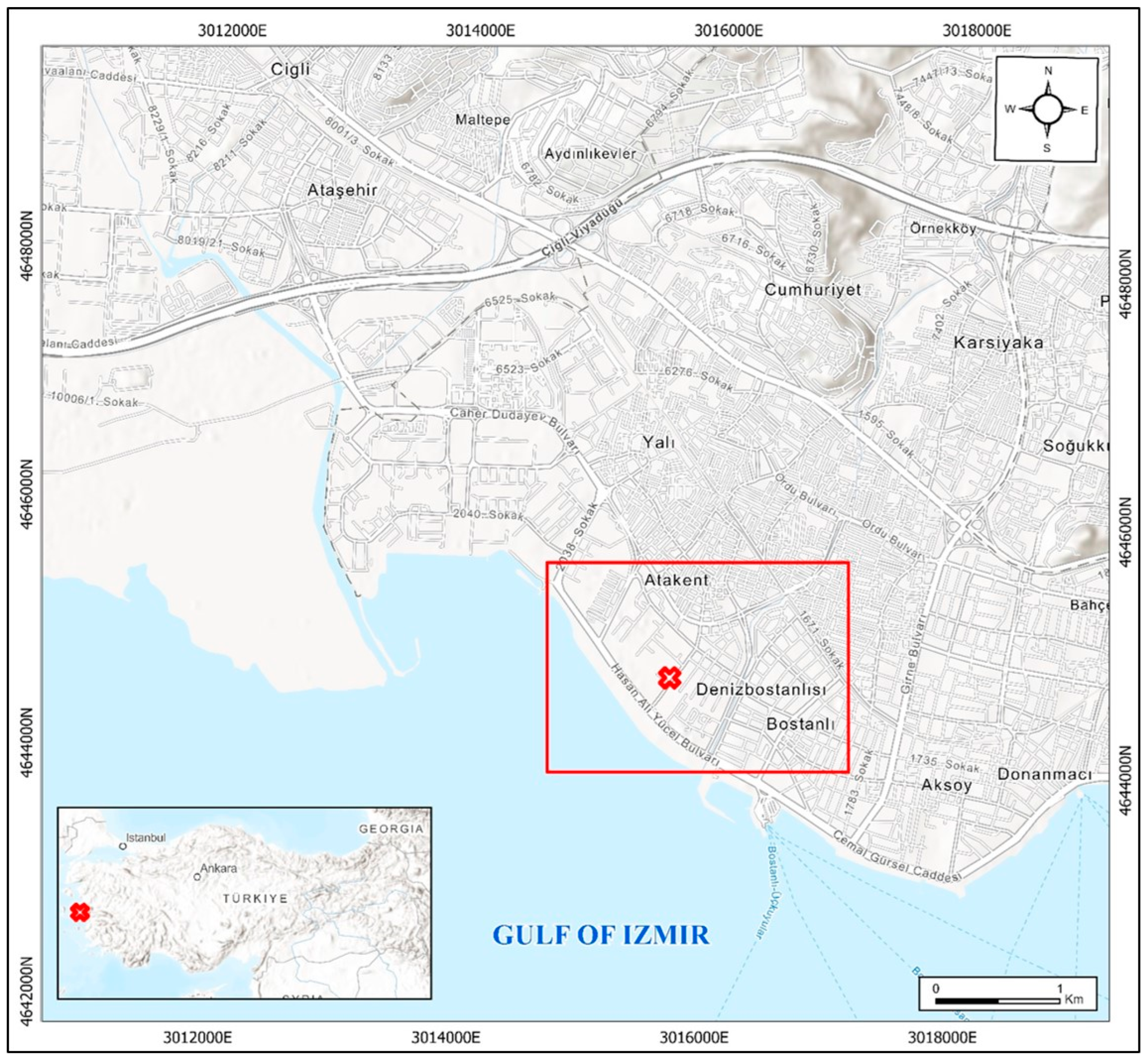
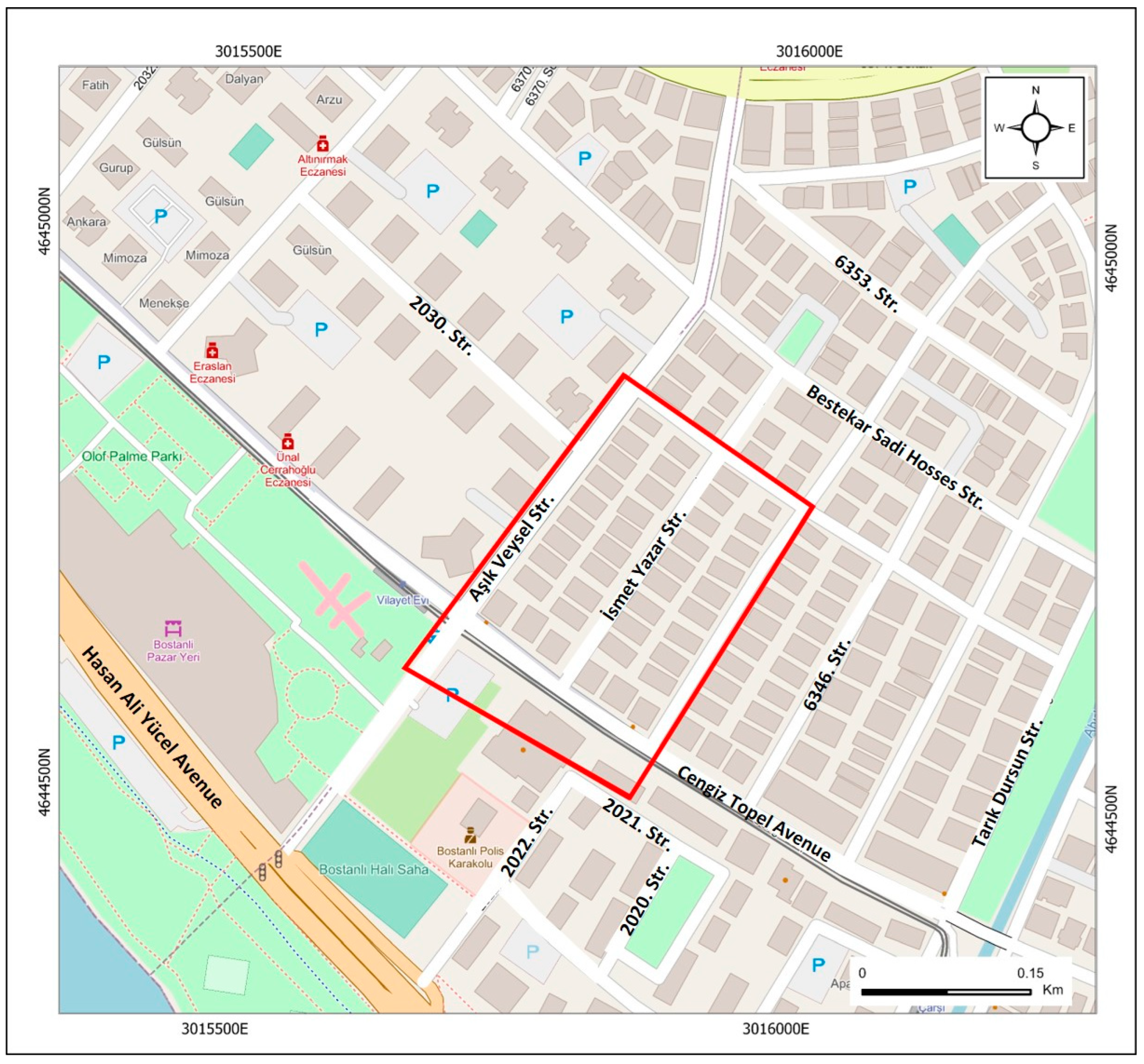


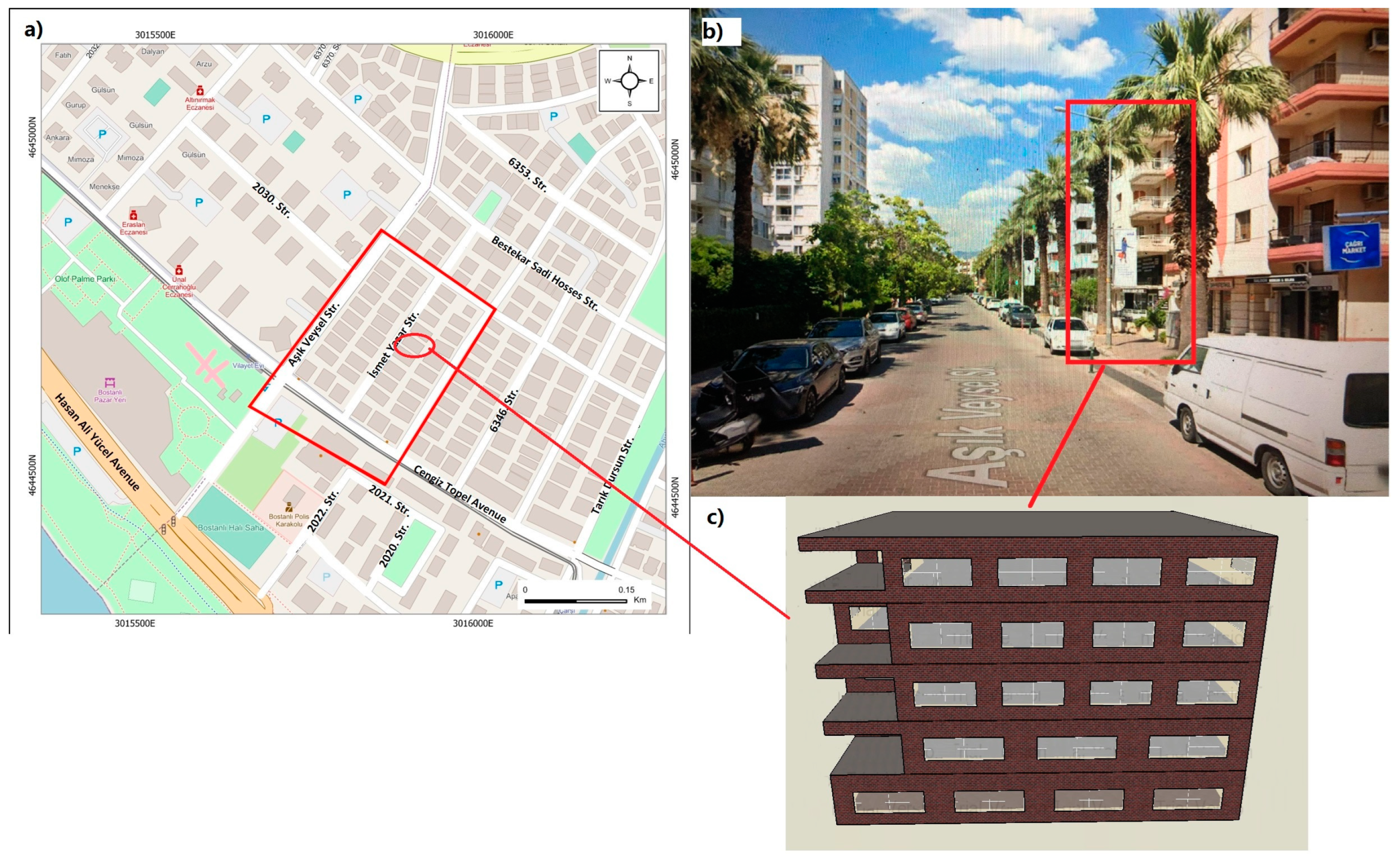
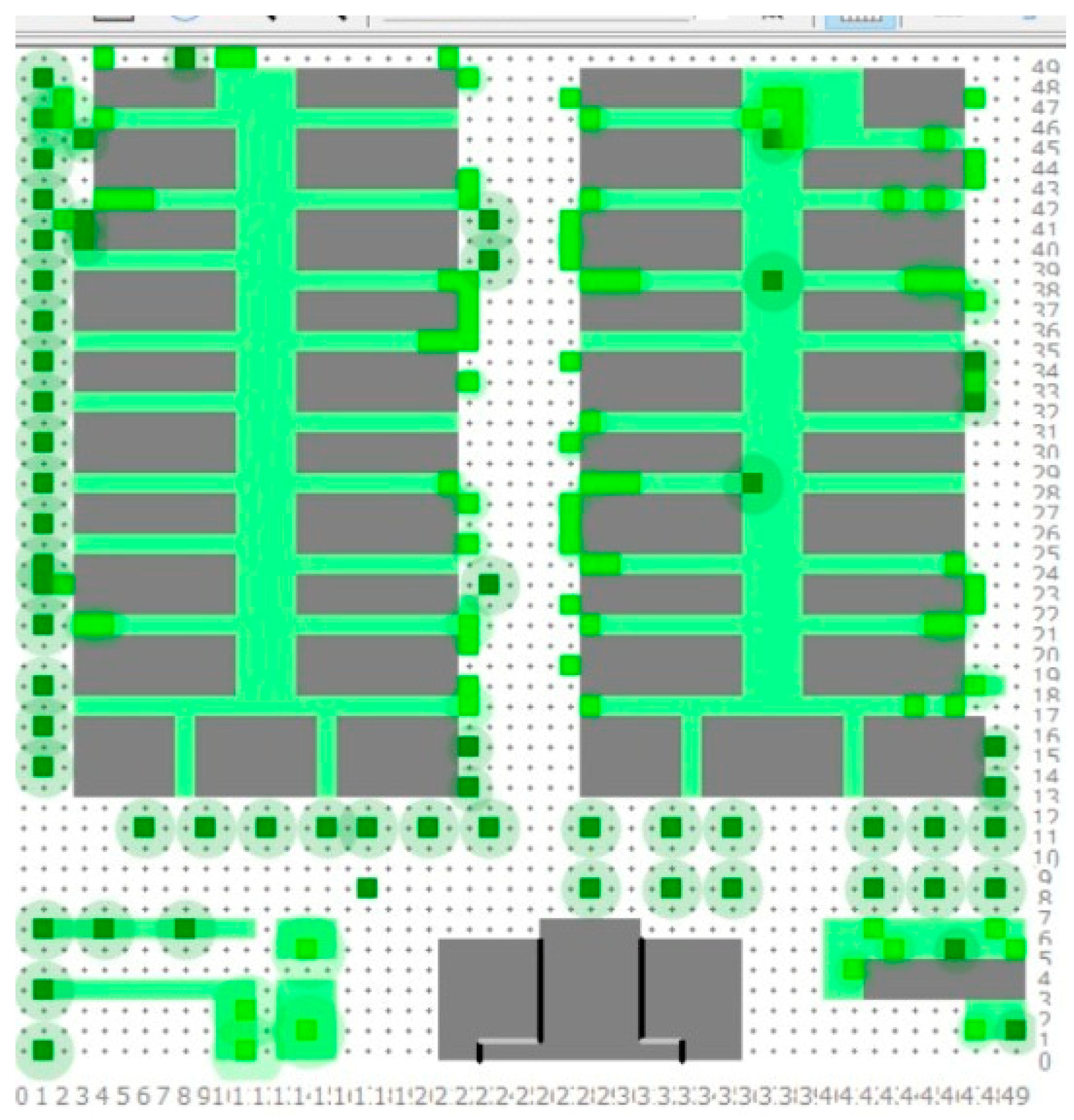
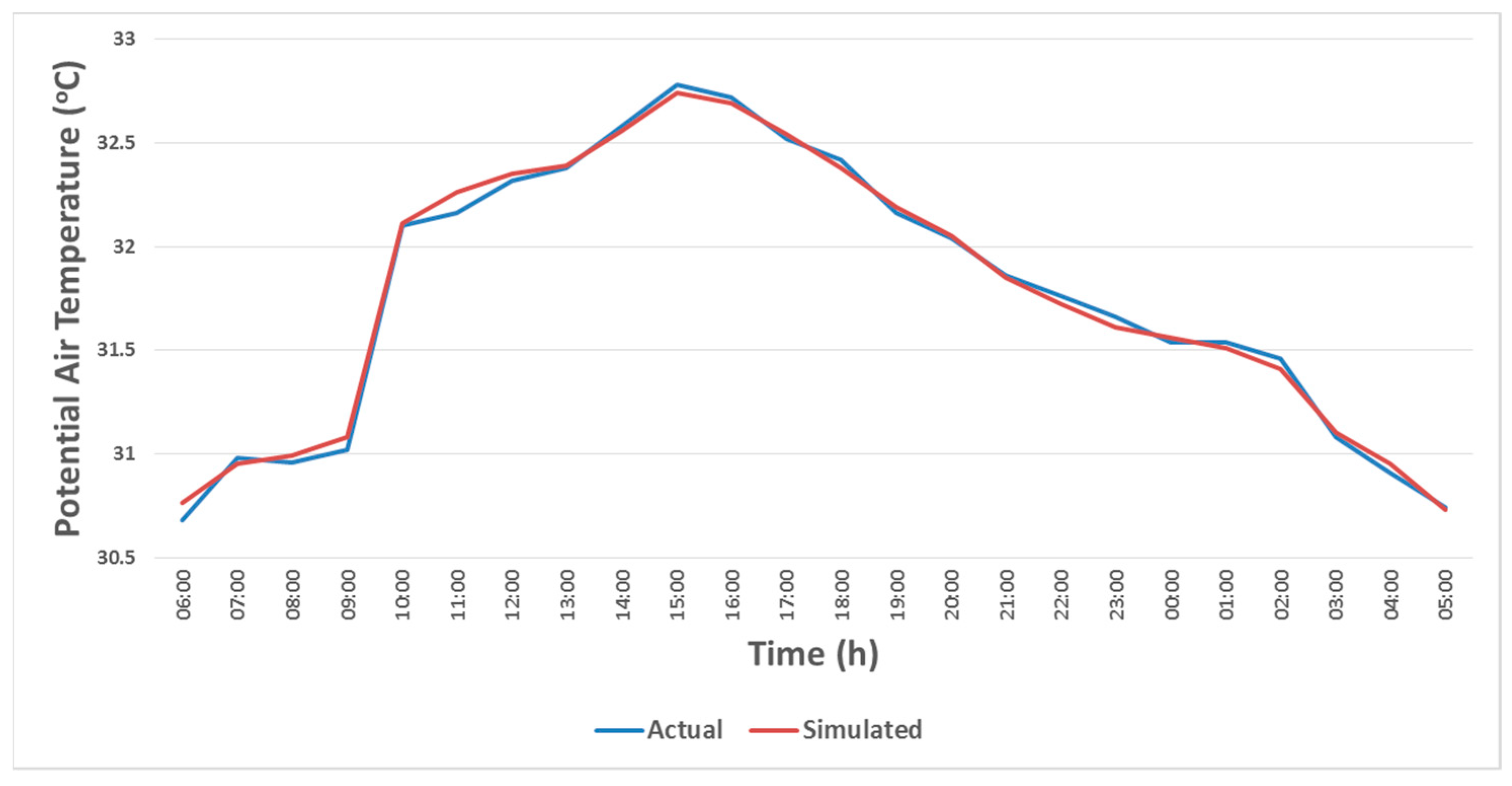

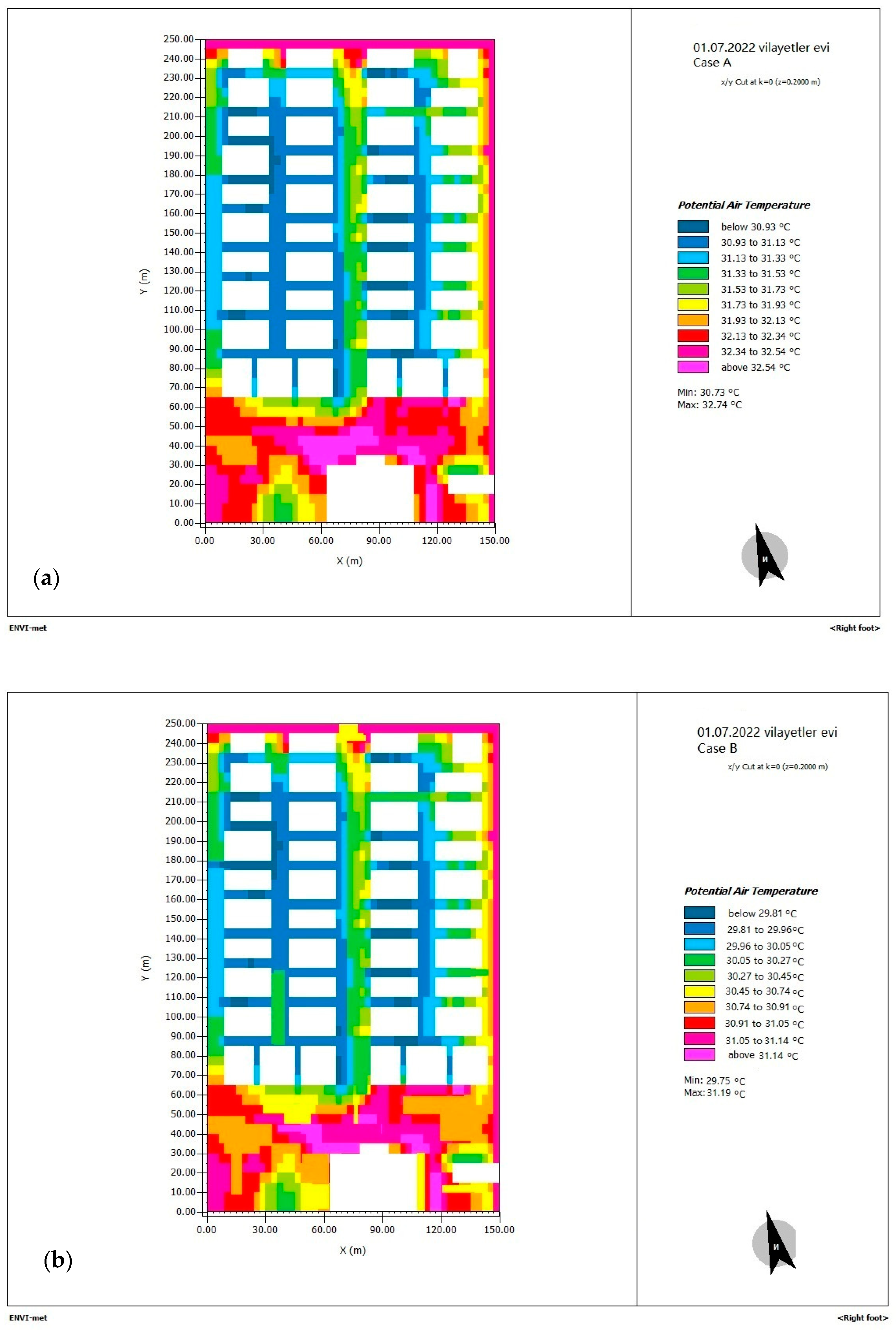
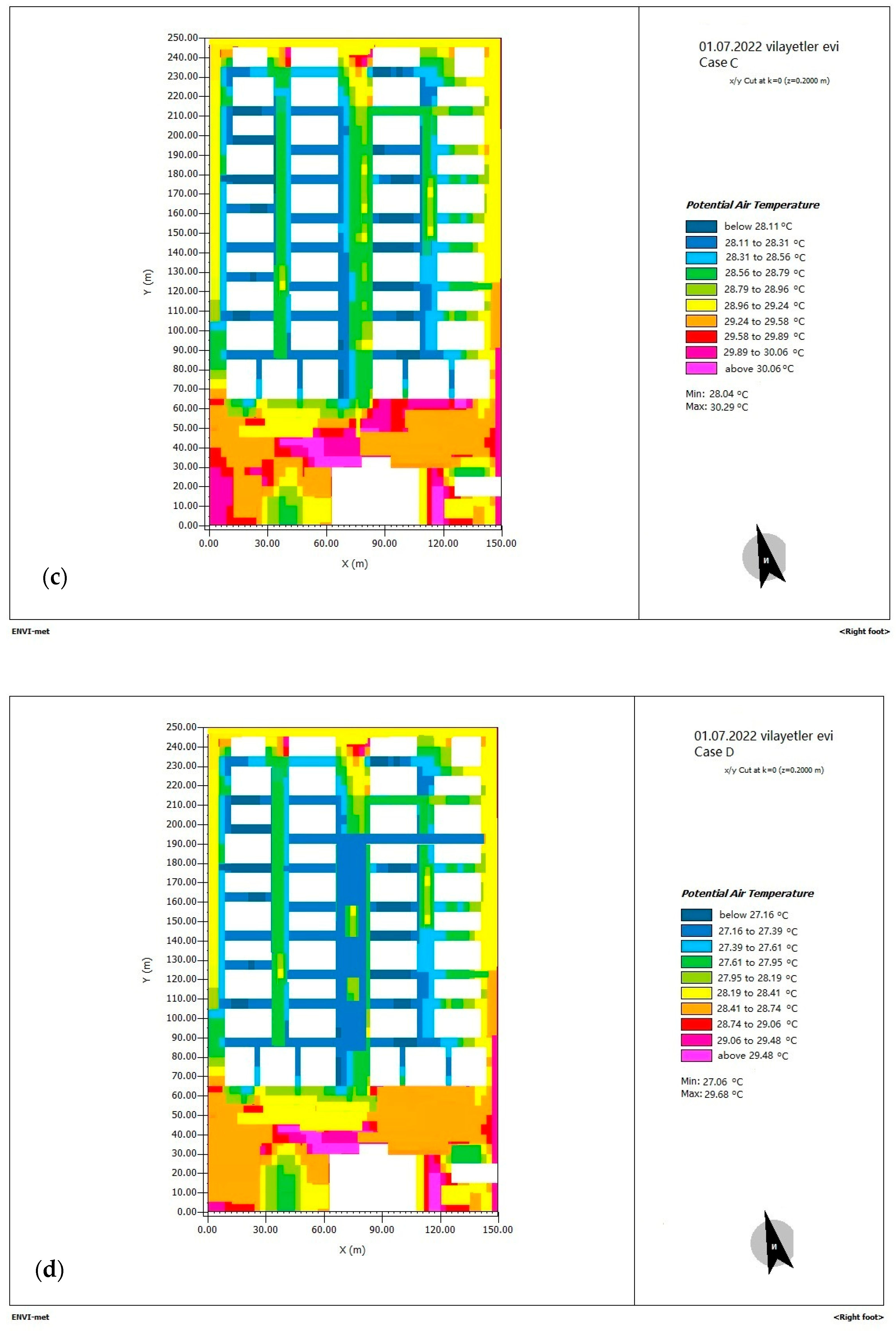

| Specifications | Wind Speed | Wind Direction |
|---|---|---|
| Measurement Range | 0 to 76 m/s (0 to 170 mph) | 0 to 355 degrees, 5-degree dead band |
| Accuracy | ±1.1 m/s (2.4 mph) or ±4% of reading, whichever is greater | ±5 degrees |
| Resolution | 0.5 m/s (1.1 mph) | 1.4 degrees |
| Specifications | Air Temperature (Tair) | Relative Humidity (RH) |
| Measurement Range | −40 to 70 °C | 0 to 100% RH, −40 to 70 °C |
| Accuracy | ±0.25 °C from −40 to 0 °C | ±2.5% from 10% to 90% (typical) to a maximum of ±3.5% including hysteresis at 25 °C; below 10% RH and above 90% RH ±5% typical |
| Resolution | 0.02 °C | 0.01% |
| Meteorological Data | Vegetation Data | Soil Data | Ground Data |
|---|---|---|---|
| Relative humidity in 2 m = 41% Wind speed in 10 m ab. ground = 2.24 m/s Wind direction: 220° Initial potential air temperature = 300 K | 61 trees in various directions with 10 m height | Impervious soil = 0.00 Partially impervious soil = 0.30 Semi-impervious soil = 0.50 Green area without connection with natural soil = 0.50 Green area with connection to natural soil = 0.70 Green area on natural soil = 1.00 | Loamy soil and pavements Initial air temperature = 25.85 °C at 21% of relative humidity |
| Envelope | Layers | Thickness (m) | U (W/m2K) |
|---|---|---|---|
| External walls | Plaster, brick, insulation | 0.41 | 0.238 |
| Roof | Plaster, brick, insulation | 0.24 | 0.236 |
| Floor | Concrete, gypsum mortar, insulation | 0.23 | 0.34 |
| Windows | Double glazed | 12 mm gap | 2.8 |
| Internal Factors | Unit | Source | |
|---|---|---|---|
| X1 | Total energy consumption | kWh/m2day | DesignBuilder |
| X2 | Thermal comfort | comfortable- hours/day | DesignBuilder |
| External factors | |||
| Y1 | Capital cost | € | Calculated from current prices, including VAT |
| Y2 | Installation flexibility | - | Experts |
| Y3 | Lifetime | year | Experts |
| Strategy | Implementation | Maximum-Minimum Potential Air Temperature (°C) | Reduction (%) | Reduction (°C) |
|---|---|---|---|---|
| Case A | Current Situation | [30.73; 32.74] | - | - |
| Case B | Changing the low-albedo materials with high-albedo ones | [29.75; 31.19] | 4.73 | 1.55 |
| Case C | Nature-based solutions | [28.04; 30.29] | 7.48 | 2.45 |
| Case D | Changing building façade materials with green roof implementation | [27.06; 29.68] | 9.36 | 3.06 |
| Strategies | Total Energy Consumption (kWh/m2day) | Thermal Comfort (Comfortable-hours/day) |
|---|---|---|
| Case A | 0.811 | 11 |
| Case B | 0.789 | 14 |
| Case C | 0.781 | 15 |
| Case D | 0.694 | 17 |
| Expert Number | x1 | x2 | y1 | y2 | y3 |
|---|---|---|---|---|---|
| 1 | 1 | 2 | 1 | 3 | 2 |
| 2 | 1 | 2 | 1 | 2 | 3 |
| 3 | 2 | 1 | 2 | 1 | 3 |
| Strategies | x1 | x2 | y1 | y2 | y3 |
|---|---|---|---|---|---|
| Case A | 0.811 | 11 | 1 | 1 | 1 |
| Case B | 0.789 | 14 | 351,764 | 3 | 3 |
| Case C | 0.781 | 15 | 210,410 | 2 | 4 |
| Case D | 0.694 | 17 | 658,788 | 4 | 2 |
| Strategies | x1 | x2 | y1 | y2 | y3 |
|---|---|---|---|---|---|
| Case A | 0 | 1 | 1 | 0 | 0 |
| Case B | 0.165391417 | 0.392857 | 1.32488 × 10−6 | 0.666 | 0.333 |
| Case C | 0.22784 | 0.24444 | 3.23469 × 10−6 | 0.333 | 1 |
| Case D | 1 | 0 | 0 | 1 | 0.666 |
| Strategies | ||||
|---|---|---|---|---|
| Case A | 0.450 | 0.365 | 0.815 | 3 |
| Case B | 0.444 | 0.317 | 0.761 | 4 |
| Case C | 0.438 | 0.678 | 1.116 | 1 |
| Case D | 0.513 | 0.541 | 1.054 | 2 |
Disclaimer/Publisher’s Note: The statements, opinions and data contained in all publications are solely those of the individual author(s) and contributor(s) and not of MDPI and/or the editor(s). MDPI and/or the editor(s) disclaim responsibility for any injury to people or property resulting from any ideas, methods, instructions or products referred to in the content. |
© 2023 by the authors. Licensee MDPI, Basel, Switzerland. This article is an open access article distributed under the terms and conditions of the Creative Commons Attribution (CC BY) license (https://creativecommons.org/licenses/by/4.0/).
Share and Cite
Turhan, C.; Atalay, A.S.; Gokcen Akkurt, G. An Integrated Decision-Making Framework for Mitigating the Impact of Urban Heat Islands on Energy Consumption and Thermal Comfort of Residential Buildings. Sustainability 2023, 15, 9674. https://doi.org/10.3390/su15129674
Turhan C, Atalay AS, Gokcen Akkurt G. An Integrated Decision-Making Framework for Mitigating the Impact of Urban Heat Islands on Energy Consumption and Thermal Comfort of Residential Buildings. Sustainability. 2023; 15(12):9674. https://doi.org/10.3390/su15129674
Chicago/Turabian StyleTurhan, Cihan, Ali Serdar Atalay, and Gulden Gokcen Akkurt. 2023. "An Integrated Decision-Making Framework for Mitigating the Impact of Urban Heat Islands on Energy Consumption and Thermal Comfort of Residential Buildings" Sustainability 15, no. 12: 9674. https://doi.org/10.3390/su15129674
APA StyleTurhan, C., Atalay, A. S., & Gokcen Akkurt, G. (2023). An Integrated Decision-Making Framework for Mitigating the Impact of Urban Heat Islands on Energy Consumption and Thermal Comfort of Residential Buildings. Sustainability, 15(12), 9674. https://doi.org/10.3390/su15129674








